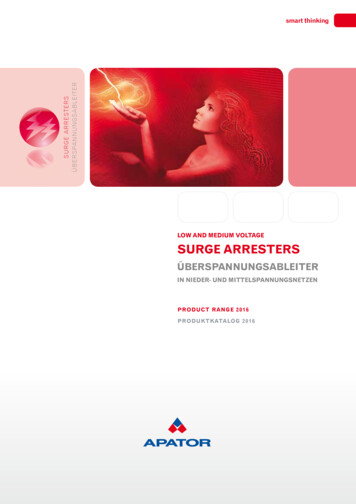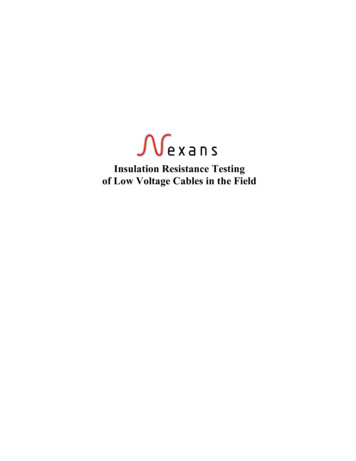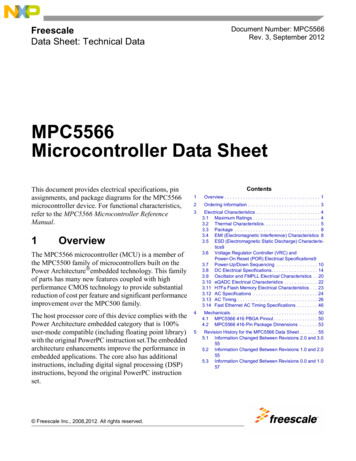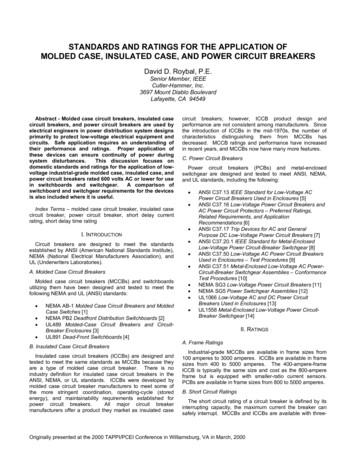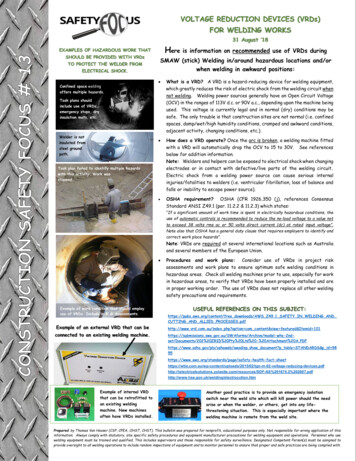
Transcription
VOLTAGE REDUCTION DEVICES (VRDs)!FOR WELDING WORKS31 August ‘18HereEXAMPLES OF HAZARDOUS WORK THATSHOULDBE PROVIDEDTestingis required toWITH VRDsidentifyleaksTO PROTECTTHEWELDER FROMSMAW (stick) Welding in/around hazardous locations and/orwhen welding in awkward positions:ELECTRICAL SHOCK.Confined space weldingoffers multiple hazards.is information on recommended use of VRDs during DANGERTask plans shouldinclude use of VRDs,What is a VRD? A VRD is a hazard-reducing device for welding equipment,which greatly reduces the risk of electric shock from the welding circuit whennot welding. Welding power sources generally have an Open Circuit Voltage(OCV) in the ranges of 113V d.c. or 90V a.c., depending upon the machine beingused. This voltage is currently legal and in normal (dry) conditions may besafe. The only trouble is that construction sites are not normal (i.e. confinedspaces, damp/wet/high humidity conditions, cramped and awkward conditions,adjacent activity, changing conditions, etc.).emergency stops, dryinsulation mats, etc.Welder is notinsulated from How does a VRD operate? Once the arc is broken, a welding machine fittedwith a VRD will automatically drop the OCV to 15 to 30V. See referencesbelow for addition information.Note: Welders and helpers can be exposed to electrical shock when changingelectrodes or in contact with defective/live parts of the welding circuit.steel groundpath.Task plan failed to identify multiple hazardswith this activity. Work wasstopped.Electric shock from a welding power source can cause serious internalinjuries/fatalities to welders (i.e. ventricular fibrillation, loss of balance andfalls or inability to escape power source). OSHA requirement? OSHA (CFR 1926.350 (j), references ConsensusStandard ANSI Z49.1 (par. 11.2.2 & 11.2.3) which states:“If a significant amount of work time is spent in electrically hazardous conditions, theuse of automatic controls is recommended to reduce the no-load voltage to a value notto exceed 38 volts rms ac or 50 volts direct current (dc) at rated input voltage”.Note also that OSHA has a general duty clause that requires employers to identify andcorrect work place hazards”.Note: VRDs are required at several international locations such as Australiaand several members of the European Union.NO Procedures and work plans: Consider use of VRDs in project riskassessments and work plans to ensure optimum safe welding conditions inhazardous areas. Check all welding machines prior to use, especially for workin hazardous areas, to verify that VRDs have been properly installed and arein proper working order. The use of VRDs does not replace all other weldingsafety precautions and requirements.Example of work condition that should employuse of VRDs. Include in Risk Assessments.Example of an external VRD that can behttp://www.vrd.com.au/index.php?option com content&view featured&Itemid oshaweb/owadisp.show document?p table STANDARDS&p id ing/electrocution.htmTIONCONSTRUCconnected to an existing welding machine.USEFUL REFERENCES ON THIS SUBJECT:https://pubs.aws.org/content/free downloads/AWS Z49.1 SAFETY IN WELDING ANDCUTTING AND ALLIED PROCESSES.pdfExample of internal VRDthat can be retrofitted toan existing weldingmachine. New machinesoften have VRDs installed.Another good practice is to provide an emergency isolationswitch near the weld site which will kill power should the needarise or when the welder, or others, get into any lifethreatening situation. This is especially important where thewelding machine is remote from the weld site.Prepared by Thomas Van Hooser (CSP, CPEA, OHST, CHST). This bulletin was prepared for nonprofit, educational purposes only. Not responsible for wrong application of thisinformation. Always comply with statutory, site specific safety procedures and equipment manufacturer precautions for welding equipment and operations. Personnel who usewelding equipment must be trained and qualified. This includes supervisors and those responsible for safety surveillance. Designated Competent Person(s) must be assigned toprovide oversight to all welding operations to include random inspections of equipment and to monitor personnel to ensure that proper and safe practices are being complied with.
INSULATING THE WELDER FROMELECTRICALLY CONDUCTIVE PATHS!EXAMPLES OF POOR AND GOOD WELDERINSULATION PRACTICES:Testing is required toidentify leaksNO!OKWelder has properly positionedhimself on a dry wooden mat.21 Sept. ‘18Duringthe pre-work size up process, welders need toensure that no part of their body is placed in a positionthat would complete a conductive path for the passage ofelectrical current.As a precaution against electrical shock andelectrocution, welders need to insulate themselves fromelectrical ground paths before welding takes place underthe following conditions:Workers are unsafely Welding in damp/wet locations.positioned on theworkpiece being welded. Welding inside metal confined spaces. While positioned on the workpiece being welded.Dry insulation mats (nonconductive material) must beprovided between the welder and the conductive path.This will insulate and protect the welder from electricalDry wood mat.Proper attire(dry and ingood condition)helps toprotect thewelder fromhot workdebris andminimizescontact withelectricallyNOconductivepaths.incidents. The mat must be large enough to offereffective protection to the welder and the welder’shelper if exposed to the same hazard.Note that a welder’s PPE is not specifically designed toprevent electric shock. It does, however, provide someprotection.Electrical resistance of damp orcontaminated clothing (including gloves) is reduced,making the risk of electrical shock possible.Remember the 3 I’s of safety:INSPECT – INSPECT- INSPECT.CASE HISTORY: While inside a metal confined space, akneeling welder accidentally contacted his face with his liveelectrode causing current flow through his torso to knees andwas electrocuted. The confined space was wet from recent rainwater and welder was not insulated from conductive path.Source: AS 1674.2 (excellent reference).A welders shoe.Danger!How oftenis welderPPEinspected onyour worksite?OKconductive metal parts and wearing poor attire anddefective footwear, was pulling a live faulty weldingcable over his shoulder and received a fatal shock.Welder not insulated from electrical ground path.Source: AS 1674.2 (excellent reference).USEFUL REFERENCES ON THIS spx?src arc welding.pdfTIONCONSTRUCCASE HISTORY: A welder, in direct contact withPrepared by Thomas Van Hooser (CSP, CPEA, OHST, CHST). This bulletin was prepared for nonprofit, educational purposes only. Not responsible for wrong application of thisinformation. Always comply with statutory, site specific safety procedures regarding overall welding safety. Personnel responsible for work site safety surveillance need to be alertfor safe welding practices and to take immediate action with supervision to eliminate hazards and to give positive reinforcement for desired conditions and practices.
NON-STANDARD USE OF CONCRETEREINFORCING BARS (REBAR)s21 September ‘18!Testing is required toDO NOT USE identifyREBARleaksOUTSIDE ITS INTENDEDPURPOSE IN REINFORCING CONCRETE!DANGERField fabricated tools do not meet material and qualitystandards. Not to be trusted. DANGER!Rebar is used to reinforce concrete by holding it together. Mostgrades of rebar are high tensile strength, brittle and can shatterunder dynamic/shock loading conditions making its usequestionable when used outside its intended purpose.Additionally, welding on rebar compounds safety concerns.Rebar is not suitable and is not safe in the fabrication oftools/devices, lifting gear, deadman anchors, etc. Such devicesmust meet good engineering and quality practices and fabricatedin accordance to relevant industry and statutory standards.Proper materials must be used, safety factors and safe workingloads (SWL) established along with proof load testing, physicalmarkings, user instructions and backup certificationdocumentation.Here are direct quotes from various industry standards relatingto this subject:Rebar tire cagePulley withwelded rebaranchorGuy wireanchorNO! OSHA - CFR 1926 Subpart Q – Appendix A: ANSI A10.9-1983 isan OSHA referenced consensus standard. ASME Standards: B30.20.2010 Below The Hook Lifting Devices, BTH1-2011 Design Of Below The Hook Lifting Devices and ASME B107 HandTools & Accessories. Documents are available from ASME.DANGERRebar used inmakeshift rigging Concrete Reinforcing Steel Institute (CRSI): OSHA Docket 20100058 (26 June 2012) Q21: “Rebar itself should never be used as a hookor loop or part of a rigging link. Only engineered products should beused for connecting cables or other bracing members”.NORebar deadmananchorRebar deadman anchorRebar manbasketWhat are loadTIONCONSTRUCRebar O-ringItems were removedfrom site anddestroyed. US Dept of Interior - Bureau of Reclamation: Section 25.3.6 Health& Safety Standards: “Prohibited use: Do not use reinforcing steel asguy attachments at deadmen or other anchorage points for scaffoldinghooks, for stirrups or as a load-bearing member of any lifting device”. National Precast Concrete Association (NPCA): “Use of rebar aslifting devices is not recommended.Properly engineered andfabricated lifting inserts shall be used in concrete works that have anadequate safety factor of four (4), SWL and certification markings.Lifting hardware shall be capable of supporting at least five (5) timesthe max load”.Concretebucketcapacities and safetyfactors of the abovenoted anchors/liftingdevices? ANSI A10.9-1983 (Safety Requirements for Construction andDemolition Operations - Concrete and Masonry Work): “Section 3.5Prohibited Uses of Reinforcing Steel: 3.5.1 Reinforcing steel shall notbe used as guy attachment at deadmen anchorage points. 3.5.2Reinforcing steel shall not be used as hooks or stirrups for scaffolding,nor shall it be used as a load bearing member of any lifting device”.Weld repair of rebar deadmananchor. 1st anchor broke understress. Danger!Such conditions dictateinvestigation into root causes andfollow-up corrective action.USEFUL REFERENCES ON THIS ommitteePages.cfm?Committee ntStreamer?documentId OSHA2010-0058-0040&attachmentNumber 1&contentType ndbooks/precasthandbook.pdf?sfvrsn 2ff1d560 168DO NOT USE MAKESHIFT DEVICES!Prepared by Thomas Van Hooser (CSP, CPEA, OHST, CHST). This bulletin was prepared for nonprofit, educational purposes only. Not responsible for wrong application of thisinformation. Always comply with statutory, site specific safety procedures regarding prohibited uses of concrete reinforcing steel. Personnel responsible for work site safetysurveillance need to be alert for rebar abuses and to take immediate action with supervision to eliminate the hazard. Field fabricated devices must be properly engineered meetingindustry standards and approved by Project Management with documentation available on site.
HAZARDS OF DOUBLE INSULATEDELECTRICAL TOOLSs!Testing is required toidentify leaks3 October c(dielectric) cases are called double-insulated and can beidentified by the double box symbol shown above. Doubleinsulated electrical tools are designed so that the inner partsare isolated physically and electrically from the outerDANGERhousing. Unlike metal case appliances, the National ElectricalCode (NEC) does not require a grounding conductor.Arrows show entry points(vents)whereforeignmaterial can enter andbuild up thereby creatinghazards. Debris can tions.Although general industry considers double insulated toolssuperior to metal case tools in preventing a shock, it isimportant for users to understand that shock hazards canstill exist when using them.HAZARDS & PRECAUTIONS OF USINGDOUBLE INSULATED TOOLS & APPLIANCES: Inspect all tools and equipment before use and reportdefects to supervision for corrective action. Never usedamaged or defective tools. Only trained persons areauthorized to use power tools. Electrical tools must never be exposed to wet or dampconditions or used with wet hands. This borders on danger! Over time dirt/dust/lint/oil, metallic/conductive particlescan enter the tool housing through the cooling vents, cracksin the casing or loose screws/connections. Such foreignmaterial can lodge inside the tool thereby voiding thedesigned insulation properties. Metal fragments and otherdebris were found inside thisNOdouble insulated grinder duringmaintenance. Manufacturersdictate periodic internal toolExample of debris enteringinspections. When was thelast time your tool techniciantool housing or from missingdid an internal inspection?contact internal energized parts. Without a groundingconductor, the tool user would become a conductor ofelectricity and would receive a shock or be electrocuted ifpositioned against conductive object(s).vents, cracks in thescrews.TESTING DOUBLE INSULATED TOOLS: Tool manufacturers specify weekly “blow outs” of air ventswith clean, dry air by designated person(s). All electrical equipment used on construction sites must beprotected by Ground Fault Circuit Interrupters (GFCI).This includes double insulated tools and appliances. GFCI’salso protect the user from damaged, frayed or brokencords.To check the insulation condition of double insulated tools, thedesignated competent person connects a megohmmeter betweeneach power conductor and any exposed metal part of the tool.Resistance test results must be low – a few hundred ohms or less Always follow statutory requirements and manufacturer’sinstructions for proper use, inspection, maintenance andstorage of electrical tools and appliances.USEFUL REFERENCES ON THIS SUBJECT:TIONCONSTRUC– which is normal. Never use tools that are damaged or with poorinsulation properties.An electrically conductive path is created should water orliquid (including profuse perspiration) enter the vents ction/electrical om/cmsdocuments/OSHA Training ToolboxTalk - Basic Electrical Safety – Double Insulated s/electrical grounding dosh/dosh publications/Electrical /safety/downloads/201007 ha3007.pdfPrepared by Thomas Van Hooser (CSP, CPEA, OHST, CHST). This bulletin was prepared for nonprofit, educational purposes only. Not responsible for wrong application of thisinformation. Always comply with statutory and site-specific safety procedures regarding safe use of electrical appliances. Supervisors are required to ensure workers using electricalequipment and tools are qualified and that effective inspection and maintenance practices are in place. Field Safety Personnel verify compliance.
!//HAZARDS OF LEVER OPERATEDDANGERCHAIN LOAD BINDERSx16 October ‘18ExperiencedDANGERunaware of their hazards. Use withcaution!construction personnel are all too familiar withserious injuries caused by Lever Operated Chain Load Binders.These types of binders are used to secure cargo to transportvehicles. These type binders are under significant stress whenengaged. When the lever is released, there is a tremendousuncontrolled release of stored energy.RATCHET LOAD BINDER.These types of binders arepreferred and are safer than leveroperated binders.These types of binders are often improperly used byinexperienced and untrained personnel by positioning themselvesin the LINE-OF-FIRE when the lever is released. Commoninjuries include MSD’s, fractures (face, teeth, hands and arms),or other serious injuries. Near misses often go unreported.Testing is required toidentify leaksLEVER OPERATED LOAD BINDER.These types of binders are often improperly used resulting in seriousinjuries and near misses. Persons do not know how to use them or areOK IMPORTANT PRECAUTIONS FOR USINGLEVER OPERATED CHAIN LOAD BINDERS: Certifying agencies require Safe Working Load (SWL) markings on bindersalong with the manufacturer’s name and a serial number. The SWL mustnever be exceeded.Binders must be compatible with, or exceed, theworking load of chain and other hardware that secures cargo. If theweakest link fails the cargo will shift creating multiple transport and roadhazards. CHEATER PIPE:Use of cheater pipes canoverstress the binder andchain. Never use them! NONO Use a lock-out device to securechain to the lever or wrap a wirearound the chain and lever. Thiswill prevent accidentaldisengagement of the lever andsubsequent cargo shifts.Danger! Always follow themanufacturer’sinstructions on safeCompliances to userinstructions aremandatory.Additionally, all bindersmust be inspected by aTIONCONSTRUCand proper use of thebinder. Operate per statutory requirements, manufacturer’sinstructions and site procedures.Users must be trained and authorized. Wear proper PPE toinclude gloves, safety glasses and hard hats. Users must alsoconduct a pre-use inspection to identify defects.Operate binders while on the ground. Make certain footing issecure. The lever must always be pressed downward.Never use a cheater pipe (handle extender) to increase leveragewhile tightening chain. The binder is overloaded if more thanone person operates the lever. Additionally, the pipe could flyoff the handle when the lever is released.Binders must be equal to or greater than the working loads ofcargo chain and other cargo securing hardware.To prevent lever disengagement during travel, wrap the looseend of the chain around the lever or tie wire around both thechain and lever. A lock-out device is preferred and willeliminate the potential danger of loos cargo. This practice isoften overlooked by operators.Be aware, when releasing the binder, of the potential ofuncontrolled energy from the stretched chain. The levermust be released using a steel pry bar under the leverpressing upward or by using the open hand under the leverand push upward. All personnel in the immediate area mustkeep out of the line-of-fire from the moving handle.Use ratchet type binders for overall safer operations.USEFUL REFERENCES ON THIS SUBJECT:https://www.youtube.com/watch?v nt/uploads/2014/03/264.pdfdesignated competentperson(s) on a periodicbasis to confirm safecondition
OSHA - CFR 1926 Subpart Q – Appendix A: ANSI A10.9-1983 is an OSHA referenced consensus standard. ASME Standards: B30.20.2010 Below The Hook Lifting Devices , BTH-1-2011 Design Of Below The Hook Lifting Devices and ASME B107 Hand Tools & Accessories . Documents are available

